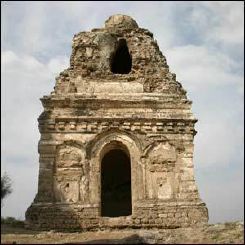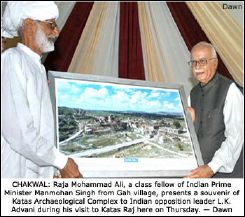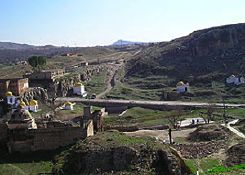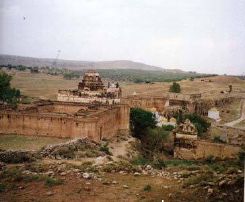 In October-November 2006, more than 200 Hindu pilgrims (yatrees) came from outside of Pakistan to visit Katas Raj.
In October-November 2006, more than 200 Hindu pilgrims (yatrees) came from outside of Pakistan to visit Katas Raj.
The mention of Katas Raj, located in the salt range 18 miles south of Chakwal, is found in Maha Bharat written in 300 BC. The etymology of this place as narrated in the old edition of Tarikh-i-Jhelum (History of Jhelum) is that according to Brahaman belief, Shiv Devta wept so profusely on the death of his beloved wife Satti that two holy ponds – one at Pushkar of Ajmair and other at Katak Shell – came into being with his tears. In Sanskrit, the word – Katak Shell – means chain of tears which later on was pronounced as ‘Katas’.
Leader of Opposition in Lok Sabha and President Bharatiya Janata Party (BJP) L.K Advani  also visited Katas Raj to inaugurate the conservation work at Satghrah temple in June this year. The photo to the right is from that occasion.
also visited Katas Raj to inaugurate the conservation work at Satghrah temple in June this year. The photo to the right is from that occasion.
According to Gen Cunningham, Katas was considered the second largest holy place in Punjab for Hindu pilgrims after Jawala Mukhi. It is said famous Pando brothers spent 12 years in Katas and built the temples of Satghara. It is said Al-Beruni also spent some time at Katas to learn Sanskrit in a linguistic university which, at that time, was established here. Temples at Katas have been transferred from the federal government to the Punjab Archaeology Department recently.


Katas Raj is also the place where Alberuni attempted to measure the circumference of the Earth, studied Sanskrit and wrote his renowned Kitab-ul-Hind (Book of Hind) which depicted the religion, scientific knowledge, and social customs of Hindus. Paras Nath Jogi drew his last breath on Katas. Jagat Guru Nanak Ji also visited the place on the 1st of Visakh. Katas came to be known as Nanaknawas and was a site of contemplation for many large groups of mystics, ascetics and jogis. According to Hindu beliefs, taking bath in the holy pond at the site washes away all sins and makes man innocent.



















































History of Katas…….. Shiva’s valley
The Katas site houses the Satgraha, a group of seven ancient temples, remains of a Buddhist stupa, a few medieval temples, havelis (means old but wide and huge compounded houses we saw and few took risk to climb on top of shivering roof where I requested them to come down since I wanted all to be safe home and be prepared for the next trip with me in Feb 25, 2007…!) and some recently constructed temples, scattered around a pond considered holy by Hindus. HISTORICAL BACKGOUND
Most of the temples, located some 40 km from the modern city of Chakwal in Pakistan’s Punjab, were built during the reign of Hindu kings. These several temples were built around 900 years ago or more. Although, the earliest of the Katas Raj temples dates back to the latter half of the 6th century AD.
The temples at Katas are mostly constructed on square platforms. The elevation of the sub shrines seems to form a series of cornices with small rows of pillars, crowned by a ribbed dome.
The Ramachandra temple is situated to the east of the Hari Singh Haveli and is closed from all sides except for an entrance on the east. The double-storied structure has eight rooms of various dimensions on the ground floor and a staircase at the south leading to the first floor. The temple has two Jharokas (balconies) that have been severely damaged.
The Hanuman temple is on the western extreme of a high rectangular enclosure with entrances on the south and the north. The temple’s ceiling is undecorated, and lime-plastered. The Shiva temple is also built on a square platform. Its entrance is a recessed round arch with faint cusps and a rectangular opening to the north.
Katas Raj temple complex is believed to date back to the Mahabharata era. There are stories about the Pandavas spending time there during their long exile. The lake in the complex is believed to have magical powers and supposed to be where Yudhishtir defeated the Yaksha with his wisdom to bring his brothers back to life.
RECENT DEVELOPMENTS
Pakistan has decided to place idols of Hindu gods in the seven temples and restore them to their original state to attract visitors. The project for the conservation of the Katas temples and stupas would be completed in shortest possible time. The budget allocated for the project is Rs.51.06 million. India is making similar contribution to the restoration of the Angkor Vat temple complex in Cambodia. Revered in India, the temple was visited earlier by India’s former deputy prime minister L.K. Advani.
The Punjab government will import idols of Hindu gods from various monuments in India to Pakistan for the restoration of the historic Katas Raj temples, The Katas site houses the Satgarha, a group of seven ancient temples, remains of a Buddhist stupa, a few medieval temples, havelis (means old but wide and huge compounded houses) and some recently constructed temples, scattered around a pond considered holy by Hindus. The government has decided to place idols of Hindu gods in the seven temples and to restore them into their original state to attract visitors. A three-member archeological team is set to leave for India today (Saturday) on an official visit. The team would visit various archaeological sites in India and collect idols of Hindu gods. The team will visit various historical sites in India such as the Taj Mahal, Agra; Fatehpur Sikri, Ajmer Sharif; Pushkar, Aurangabad; Daultabad; Ajanta; Varanasi between January 20 and 30.
Main purpose of a Punjab Government tour would be gathering information about the gods, their rituals and decoration of their temples, which would be completed in February, and pictures and idols of the gods would be bought from India and designers would be hired to prepare replicas. The project for the conservation of the Katas temples and stupas would be completed in February. The total budget allocated for the project is Rs 51.06 million, he added.
Apart from sculptures unearthed by the Department of Archaeology dating back to the 6th and 7th centuries, the Salt Ranges are dotted with Hindu temples, of which the most notable is the Katas Raj. Located 25 kilometers from Chakwal District, Katas Raj temples are notable in many ways.
OTHER INTERESTING POINTS
The temple was not abandoned by local Hindus when they migrated to East Punjab in 1947. Many legends sacred to the Hindus are associated with it, some of them involving Shiva himself. It has always been the site of holy pilgrimage. Even nowadays, through an agreement between India and Pakistan, Hindu worshippers perform a pilgrimage to the temple every year and bathe in the sacred pool around which Katas Raj is built.
While Katas Raj has not received the publicity that it deserves, the two semi-ruined temples of the Hindushahiya period (650-950 AD) have been frequently photographed by newspapers and history journals. The remains are very beautifully carved and conform to the best in temple architecture.
Katas Raj is also held sacred by Hindus for other reasons.
Legend says;
…… that the five Pandava brothers, heroes of the Sanskrit epic Mahabharata, stayed here for four out of the 14 years that they spent in exile. While it takes a little effort to get there by road – one has to go off the Grand Trunk Road – Katas Raj is partially visible on the train route from Lahore to Rawalpindi. It is a picturesque sight.
Many local legends are associated with Katas, some linked with the five Pandava brothers, heroes of the epic Mahabharata, who (supposedly) stayed here for some of the years that they spent in exile. Another involves the death of Shiva’s wife Satti, so the story goes that when she died he cried so much and for so long, that his tears created two holy ponds – one at Pushkara in Ajmer in India and the other at Ketaksha, which literally means raining eyes, in Sanskrit. It is from this name that the word Ketas is derived.
What was a holy pond for Hindus is today littered with garbage, while the pictorial images inside the temples have disappeared with ravages over time, and disregard of authorities. The temples of Katas can perhaps be saved from further damage if a boundary is constructed around the temple complex, and Hindu pilgrims are encouraged to frequent the place. Might such initial measures exert a moral pressure on those responsible for renovation would be the next question.
The Salt Ranges have also been yielding prehistoric finds.
While some local experts place the fossils discovered in the period between 6000 and 7000 BC, the fact remains that they have not yet been examined by trained paleontologists from the West. A large number of bones of the limbs and vertebrae of giant animals resembling the extinct mammoth and dinosaur, have been found at some sites. “An entire range of low mountains in the area appears to be fossilised, revealing to the naked eye layer upon layer of a variety of plants and soils,â€
The Historical City of Chakwal
Katas Raj
It is located in the middle of salt range mountains 18 miles away from Chakwal city. The epic poem Maha-Bharat, written circa 300BC contains its references. The area is now known as Makhial. In olden days the place was called Kot Cheena where an annual festival was held in March-April where the pilgrimage performed holy bath in the waters of a pond called Katak-Shail or Ketaksha (flowing- tears or raining eyes) filled by the Lord Shev’s left eye and water filled in a pond called Pushkar or Pokhar at Ajmair (now in India) from Lord Shev’s right eye, as a result of the death of his wife Sati, daughter of Dikshia.
The word Katak-Shail later on changed into Katsha or Kataksha and now Katas. This pond is locate 200 feet above sea level near Ganian rain / spring water way where its water was merged through a 122 feet long under ground water tunnel-way which was used for irrigation. The wall around the front of pond was built by Raja Pataik or Pattak who was a minister of some Dehli King; the wall is 2.5 feet thick and 19 feet high to protect water and its surrounding dilapidated buildings. Near Ganian water stream there are two hills about 200 feet high. On the southern hills the ruins of old town Kotera , now called Sadhu-Ka-Ghar (Sadhu’s house) was found. Here we also find ruins of Sat-Gharra Mandir (temple) which is considered to be the oldest temple of all. The famous Pandu brothers spent few of their 12-14 years here. Gen Cunningham cited some stupas (Buddhist’s temples) or some more mandirs (Hindu temples) here which were destroyed by the vagaries of weather and one can not forget the torrential rains of September 1948 which destroyed the local geo-contours.
In recent days Pandit Mohan Lal from India, visited the place in November 1983 and cited the name of Lord Shankar or Lord Shev Maharaj for calling the place as Kay-TaiKash Raj “King of Snakesâ€
I visited this a few years ago. Very depressing in maintainance.
Nice writeup. First time I am hearing of these and glad to know that people are writing about these issues.
History of Katas…….. Shiva’s valley
The Katas site houses the Satgraha, a group of seven ancient temples, remains of a Buddhist stupa, a few medieval temples, havelis (means old but wide and huge compounded houses we saw and few took risk to climb on top of shivering roof where I requested them to come down since I wanted all to be safe home and be prepared for the next trip with me in Feb 25, 2007…!) and some recently constructed temples, scattered around a pond considered holy by Hindus. HISTORICAL BACKGOUND
Most of the temples, located some 40 km from the modern city of Chakwal in Pakistan’s Punjab, were built during the reign of Hindu kings. These several temples were built around 900 years ago or more. Although, the earliest of the Katas Raj temples dates back to the latter half of the 6th century AD.
The temples at Katas are mostly constructed on square platforms. The elevation of the sub shrines seems to form a series of cornices with small rows of pillars, crowned by a ribbed dome.
The Ramachandra temple is situated to the east of the Hari Singh Haveli and is closed from all sides except for an entrance on the east. The double-storied structure has eight rooms of various dimensions on the ground floor and a staircase at the south leading to the first floor. The temple has two Jharokas (balconies) that have been severely damaged.
The Hanuman temple is on the western extreme of a high rectangular enclosure with entrances on the south and the north. The temple’s ceiling is undecorated, and lime-plastered. The Shiva temple is also built on a square platform. Its entrance is a recessed round arch with faint cusps and a rectangular opening to the north.
Katas Raj temple complex is believed to date back to the Mahabharata era. There are stories about the Pandavas spending time there during their long exile. The lake in the complex is believed to have magical powers and supposed to be where Yudhishtir defeated the Yaksha with his wisdom to bring his brothers back to life.
RECENT DEVELOPMENTS
Pakistan has decided to place idols of Hindu gods in the seven temples and restore them to their original state to attract visitors. The project for the conservation of the Katas temples and stupas would be completed in shortest possible time. The budget allocated for the project is Rs.51.06 million. India is making similar contribution to the restoration of the Angkor Vat temple complex in Cambodia. Revered in India, the temple was visited earlier by India’s former deputy prime minister L.K. Advani.
The Punjab government will import idols of Hindu gods from various monuments in India to Pakistan for the restoration of the historic Katas Raj temples, The Katas site houses the Satgarha, a group of seven ancient temples, remains of a Buddhist stupa, a few medieval temples, havelis (means old but wide and huge compounded houses) and some recently constructed temples, scattered around a pond considered holy by Hindus. The government has decided to place idols of Hindu gods in the seven temples and to restore them into their original state to attract visitors. A three-member archeological team is set to leave for India today (Saturday) on an official visit. The team would visit various archaeological sites in India and collect idols of Hindu gods. The team will visit various historical sites in India such as the Taj Mahal, Agra; Fatehpur Sikri, Ajmer Sharif; Pushkar, Aurangabad; Daultabad; Ajanta; Varanasi between January 20 and 30.
Main purpose of a Punjab Government tour would be gathering information about the gods, their rituals and decoration of their temples, which would be completed in February, and pictures and idols of the gods would be bought from India and designers would be hired to prepare replicas. The project for the conservation of the Katas temples and stupas would be completed in February. The total budget allocated for the project is Rs 51.06 million, he added.
Apart from sculptures unearthed by the Department of Archaeology dating back to the 6th and 7th centuries, the Salt Ranges are dotted with Hindu temples, of which the most notable is the Katas Raj. Located 25 kilometers from Chakwal District, Katas Raj temples are notable in many ways.
OTHER INTERESTING POINTS
The temple was not abandoned by local Hindus when they migrated to East Punjab in 1947. Many legends sacred to the Hindus are associated with it, some of them involving Shiva himself. It has always been the site of holy pilgrimage. Even nowadays, through an agreement between India and Pakistan, Hindu worshippers perform a pilgrimage to the temple every year and bathe in the sacred pool around which Katas Raj is built.
While Katas Raj has not received the publicity that it deserves, the two semi-ruined temples of the Hindushahiya period (650-950 AD) have been frequently photographed by newspapers and history journals. The remains are very beautifully carved and conform to the best in temple architecture.
Katas Raj is also held sacred by Hindus for other reasons.
Legend says;
…… that the five Pandava brothers, heroes of the Sanskrit epic Mahabharata, stayed here for four out of the 14 years that they spent in exile. While it takes a little effort to get there by road – one has to go off the Grand Trunk Road – Katas Raj is partially visible on the train route from Lahore to Rawalpindi. It is a picturesque sight.
Many local legends are associated with Katas, some linked with the five Pandava brothers, heroes of the epic Mahabharata, who (supposedly) stayed here for some of the years that they spent in exile. Another involves the death of Shiva’s wife Satti, so the story goes that when she died he cried so much and for so long, that his tears created two holy ponds – one at Pushkara in Ajmer in India and the other at Ketaksha, which literally means raining eyes, in Sanskrit. It is from this name that the word Ketas is derived.
What was a holy pond for Hindus is today littered with garbage, while the pictorial images inside the temples have disappeared with ravages over time, and disregard of authorities. The temples of Katas can perhaps be saved from further damage if a boundary is constructed around the temple complex, and Hindu pilgrims are encouraged to frequent the place. Might such initial measures exert a moral pressure on those responsible for renovation would be the next question.
The Salt Ranges have also been yielding prehistoric finds.
While some local experts place the fossils discovered in the period between 6000 and 7000 BC, the fact remains that they have not yet been examined by trained paleontologists from the West. A large number of bones of the limbs and vertebrae of giant animals resembling the extinct mammoth and dinosaur, have been found at some sites. “An entire range of low mountains in the area appears to be fossilised, revealing to the naked eye layer upon layer of a variety of plants and soils,â€